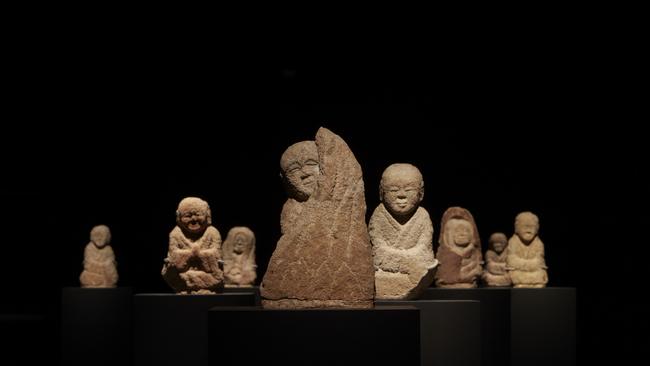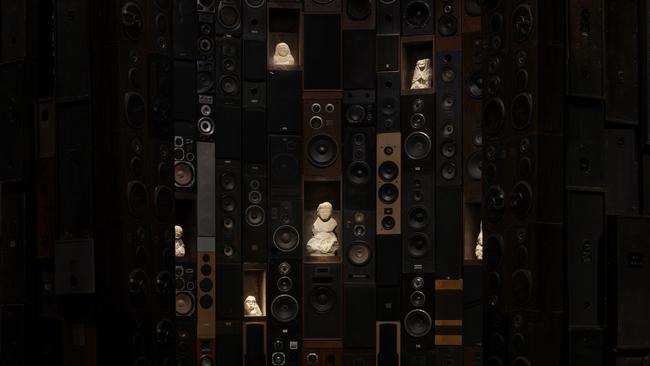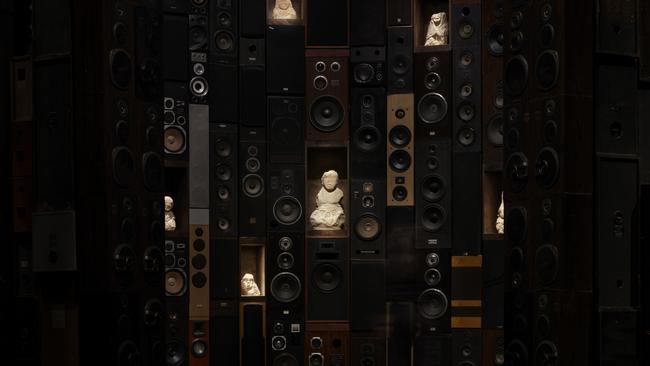Chasing Buddha, Zen in the city at Powerhouse Museum
These small, carved figures sitting under soft lights will draw you into their meditative presence.

Homer looks back to the heroic but tragic period of the Trojan War, four centuries before his own age, with a light of moral awareness and human self-consciousness that could not have existed in the Bronze Age. It is as though for the first time men wake up, consider their lives and their actions and ask why they are doing what they are doing, instead of simply going through the motions as though in a dream. His characters are still caught in the nightmare of war and more broadly of a fate as meaningless as any modern concept of the absurd, but they are fully aware of their predicament and they know that their only freedom lies in resolutely facing and enduring the world of fate.
A couple of centuries later, wherever there was civilisation and literacy, the human mind seems to take a further step forward in self-critical thinking and self-awareness: around the sixth and fifth centuries BC, Confucius and Lao Tsu were active in China, Buddha in India, Zoroaster in Persia, and the pre-Socratic philosophers in Greece. Their paths were different, for some emphasised social order and moral practice, some mystical experience, and others reason and the beginnings of scientific investigation. But all opened new dimensions of thought and awareness unimaginable to the men and women who had preceded them for thousands of years.

One of these movements was destined to spread across the whole of the Eurasian continent. Buddhism arose, as far as we can see, from the historical Buddha’s powerful but simple insights about the sources of human suffering and its remedies, escaping from the tangles of Hindu conceptions of morality and karma. Human life is beset by suffering; suffering is caused by desire or attachment; by eliminating attachment, we eliminate suffering. These fundamental ideas are not even inherently theistic; they invite a moral practice rather than any form of worship.
Such was the irrepressible religious instinct of the Indian subcontinent, however, that Buddhism was soon turned into an almost unimaginably complex religion, with Buddhas of the past and the future and countless other intermediate beings like Bodhisattvas, as well as demons and spiritual beings. Its development into the various branches known as Theravada, Mahayana (which calls Theravada ‘Hinayana’ or the lesser vehicle) and Tantrism – a subject discussed here last year – and its proliferating theological speculations grew impenetrable to rational analysis. Buddhism was adopted by the Mauryan Emperor Ashoka – whose grandfather Chandragupta is said to have seen Alexander the Great as a boy – in the third century BC, and from there it spread to the Greco-Indian regions of north India and Afghanistan. It was in Gandhara that Buddha was first represented in human form, on the model of Apollo, and this anthropomorphic image travelled as far as China and Japan, while in the opposite direction, Buddhist teachers even reached Alexandria and probably had an influence that is only now being understood.
Buddhism travelled along the Silk Road to reach China, and then Japan and Korea. Its subsequent history in these countries is complex, at times embraced by the state and at times repressed. Buddhism flourished in China in the early centuries of the Christian era, until it was brutally repressed in the ninth century, at the end of the Tang period. Thousands of monasteries and temples were destroyed, their treasures looted and the monks and nuns expelled. The Confucians, who had been savagely persecuted themselves by the first Qin emperor, were now an integral part of the state and encouraged the view of Buddhism as an alien and non-Chinese religion.
Korea was later to adopt Buddhism and also later to repress it. By the Goryeo dynasty, which unified and named the Korean peninsula (918-1392), it became the state religion; the Korean Confucians were still hostile, but they did not gain the support of the state until the rise of the following Joseon Dynasty (1392-1910). Then they did their best to destroy monasteries and temples as well, although they never succeeded in suppressing the religion altogether.
This is the background to a remarkable and beautiful exhibition at the Powerhouse Museum in Sydney, Five Hundred Arhats from Changnyeongsa Temple. The temple was destroyed during the Joseon persecutions, and the site was only rediscovered by accident, as related in an excellent introduction by Min-Jung Kim, the exhibition’s curator, on the Powerhouse website. A farmer and his wife had bought a property near the reputed location of the lost temple, and he was clearing some of the land twenty years ago when he came upon some mysterious carved stones.
He reported his discovery to the authorities, and archaeological excavation on the site revealed hundreds more carved stones, most of them with evidence of deliberate damage and vandalism during the monastery’s destruction, probably some six hundred years ago. A few of these stones represented Buddhas or Bodhisattvas, but the vast majority were images of arhats, as they are known in Sanskrit, or nahan in Korean. The 328 arhats may have belonged to an original set of 500, or at least refer to a legend about 500 arhats, hence the title of the exhibition.
Arhats are beings who have achieved enlightenment but defer their own nirvana in order to remain in this world and help those who are still seeking the way. This definition may sound very close to that of a Bodhisattva, and while there are apparently important theological distinctions between the two, the most important practical difference seems to be that arhats are venerated in the Theravada tradition, while the Mahayana has a special cult of Bodhisattvas.
What is more important for our purposes is that all of these arhats are represented as sitting in meditation, in accordance with the dominant form of Korean Buddhism at the time. The Indian monk Bodhidharma, about whom there are many legends and who was the inspiration for the Japanese Daruma doll, came to China about fifteen centuries ago, bringing with him the practice of meditation as a path to enlightenment that was more effective than the study of scriptures.
The Sanskrit word for sitting in meditation is Dhyana, which became Chan in Chinese and Zen in Japanese. This new approach was a radical simplification that dispensed with endless studies of sacred texts and their commentaries, and ink painters inspired by Chan or Zen love to represent monks laughing and tearing up the Sutras as a vain distraction from the pursuit of enlightenment, or rather its discovery, since even the pursuit of enlightenment is a kind of attachment, and enlightenment is found when we give up all forms of attachment and desire, even this one. Hence the famous Zen saying that looking for enlightenment is like searching for an ox when you are already riding on it.

To enter the exhibition is to encounter, in a vast dark room, some fifty small carved figures sitting in meditation. They are raised on plinths and carefully picked out by soft spotlights so that everything else drops away into the gloom. You feel at once drawn into their stillness and presence, and this impression only deepens as your eyes get used to the low light levels and as you walk up and down, encountering each of the figures in turn. A gentle soundscape of bird sounds deepens the impression of quietness and silence.
When we look at these figures carefully, we are struck by a paradox that is in fact profoundly Zen in spirit: that the figures are so poignantly expressive and yet so rudimentary in their carving. As anyone who has ever tried to carve in wood or stone will have found, it is very hard to escape the sense of the block with which you start. You think you are cutting away enough to make a fully-rounded volume, and then discover to your disappointment that you have barely more than engraved the outline of a shape into a mass that still remains obstinately blockish and flat.
It may not strike a casual viewer, who only looks at the field of arhats from the front of the room, but if you examine any of them closely and especially from the side, you will be surprised by how shallow the relief is and how flat the features really are. There is little doubt that this is deliberate; it is typical of Zen to reject facility and virtuosity and to embrace the rough and the ostensibly ill-formed, just as Zen potters prefer humble forms and embrace the accidents of glazes and the kiln.
Here it is clear that the carvers of these figures have sought to cut away as little stone as possible, as we can see not only from their unformed backs, no more than roughed out or hacked away from a cliff face, but especially from those cases – one conspicuous – where the face is surrounded by the uncut and still oxidised remains of the original surface of the rock. The striking minimalism of these carvings is like a metaphor of the minimal individuality yet remaining in these beings who have almost but not quite taken their leave of the world of determinate form to return to the wholeness of undifferentiated being.
And yet their distinct expressions – subtle yet profound – are equally striking, further evidence if it were needed that the rudimentary carving is a deliberate aesthetic choice. These arhats have stayed behind with us in the world of form out of compassion for our sufferings; and as we look at each of them separately, it is as though we are seeing their meditative peace and equilibrium lightly disturbed by passing impressions of the sufferings of those of us who are not yet wholly free of the bonds of attachment.
The second part of the exhibition is designed by a contemporary artist, Kim Seung Young, and although its choice of materials may sound incongruous, is actually highly effective. We enter a kind of cylindrical space like the inside of a tall tower made from over 1000 disused speakers, in which a figure of Buddha, facing us in the centre, is accompanied by a number of further arhats, some fragmentary, set sparsely in little bays. A soundscape surrounds us, as though emitted by the old speakers, sometimes low and infrequent, at other times faster and busier, evoking the bustle of city life.
We can’t help recalling that these speakers, hundreds of them, must have blared out thousands of hours of now forgotten noise over many years, most of it ephemeral commercial music used as a psychotropic remedy for depression or as a distraction from preoccupation. Now they are silent, or almost silent: all that remains is this bare whispering and rustling of indistinct sounds, like a metaphor of the ephemeral thoughts and involuntary recollections that pass through a mind that is otherwise composed in the stillness of meditation.
Five Hundred Arhats from Changnyeongsa Temple, Powerhouse Museum, until May 15.




To join the conversation, please log in. Don't have an account? Register
Join the conversation, you are commenting as Logout